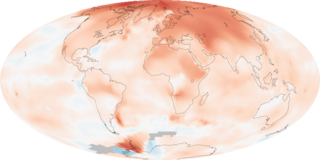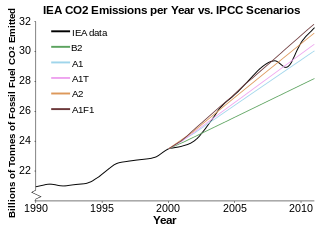Global warming
From Wikipedia, the free encyclopedia
This article is about the current change in Earth's climate. For general discussion of how the climate can change, see Climate change. For other uses, see Global warming (disambiguation).
Global warming is the rise in the average temperature of Earth's atmosphere and oceans since the late 19th century and its projected continuation. Since the early 20th century, Earth's mean surface temperature has increased by about 0.8 °C (1.4 °F), with about two-thirds of the increase occurring since 1980.[2] Warming of the climate system is unequivocal, and scientists are more than 90% certain that it is primarily caused by increasing concentrations of greenhouse gases produced by human activities such as the burning of fossil fuels anddeforestation.[3][4][5][6] These findings are recognized by the national science academies of all major industrialized nations.[7][A]
Climate model projections were summarized in the 2007 Fourth Assessment Report (AR4) by the Intergovernmental Panel on Climate Change (IPCC). They indicated that during the 21st century the global surface temperature is likely to rise a further 1.1 to 2.9 °C (2 to 5.2 °F) for their lowest emissions scenario and 2.4 to 6.4 °C (4.3 to 11.5 °F) for their highest.[8] The ranges of these estimates arise from the use of models with differing sensitivity to greenhouse gas concentrations.[9][10]
Future warming and related changes will vary from region to region around the globe.[11] The effects of an increase in global temperature include arise in sea levels and a change in the amount and pattern of precipitation, as well a probable expansion of subtropical deserts.[12] Warming is expected to be strongest in the Arctic and would be associated with the continuing retreat of glaciers, permafrost and sea ice. Other likely effects of the warming include a more frequent occurrence of extreme weatherevents including heat waves, droughts and heavy rainfall, ocean acidification and species extinctions due to shifting temperature regimes. Effects significant to humans include the threat to food security from decreasing crop yields and the loss of habitat from inundation.[13][14]
Proposed policy responses to global warming include mitigation by emissions reduction, adaptation to its effects, and possible futuregeoengineering. Most countries are parties to the United Nations Framework Convention on Climate Change (UNFCCC),[15] whose ultimate objective is to prevent dangerous anthropogenic (i.e., human-induced) climate change.[16] Parties to the UNFCCC have adopted a range of policies designed to reduce greenhouse gas emissions[17]:10[18][19][20]:9and to assist in adaptation to global warming.[17]:13[20]:10[21][22] Parties to the UNFCCC have agreed that deep cuts in emissions are required,[23] and that future global warming should be limited to below 2.0 °C (3.6 °F)relative to the pre-industrial level.[23][B] Reports published in 2011 by theUnited Nations Environment Programme[24] and the International Energy Agency[25] suggest that efforts as of the early 21st century to reduce emissions may be inadequate to meet the UNFCCC's 2 °C target.



No comments:
Post a Comment